1997 CHEVROLET S10 steering
[x] Cancel search: steeringPage 138 of 402
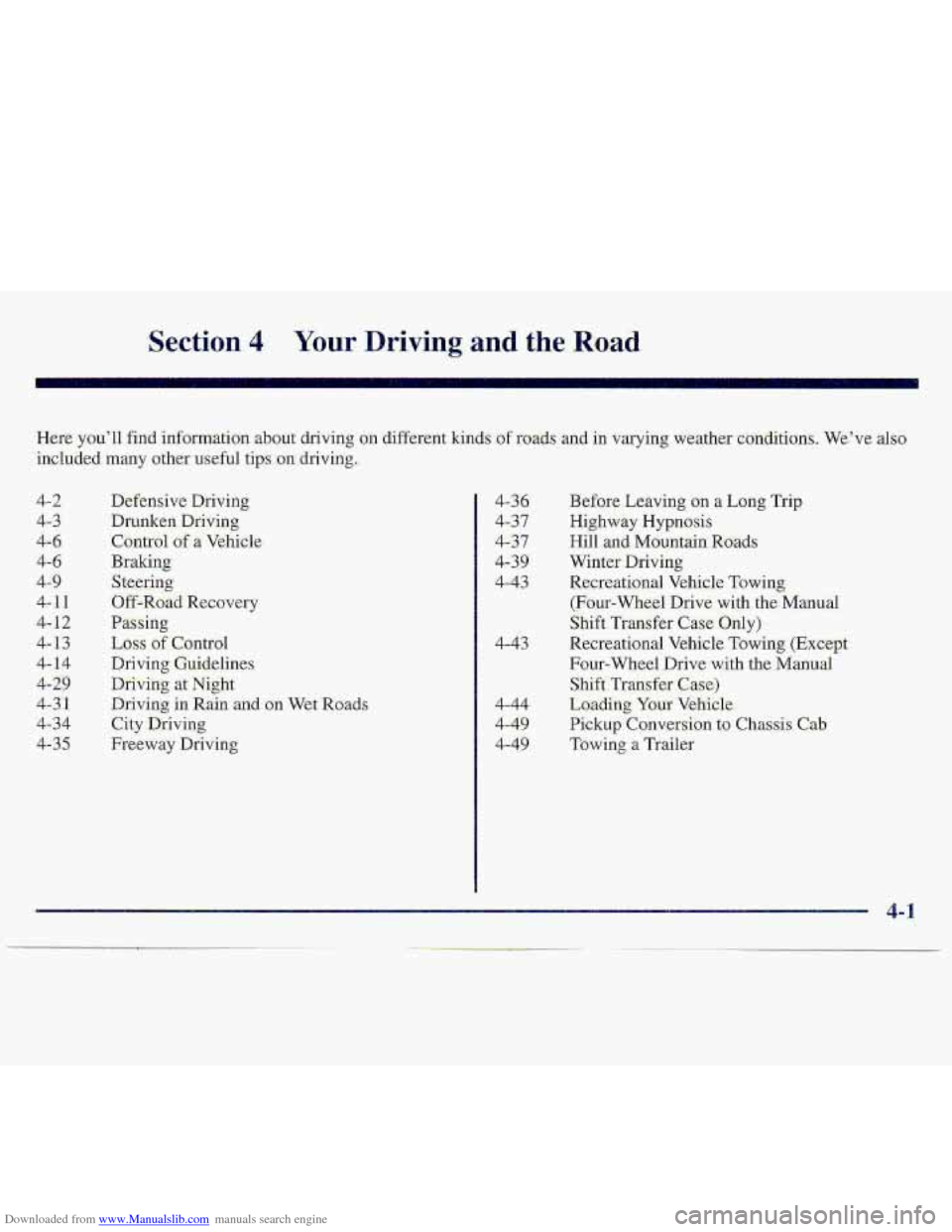
Downloaded from www.Manualslib.com manuals search engine Section 4 Your Driving. and the- Road
Were-. you’ll find information ,ab.aut driving on different kinds o.frodds and in varyir@ weatkr-er c’oiiditians. We”ve ako
inc1ude.d many other useful tips ;on driving.
4-2
4-3
4-6
4-6
4-5)
4-1
1
4-12
4-13
4-14
4-2.9
4-3..1
4-34
4-35
Defmsive.Driving
Drunken Driving
Control of a Vehicle
Braking
Steering
Off-Road Recovery
Passing
Loss. of Control
Driving Guidelines
Diiving at-Night
Driving in Rain .and on Wet Roads
City Driving
Freeway Driving
4-3 6
4-37
437
4-39
4-43
4-43
4--44-
4-49
4-49
B-ef6x.e Leaving- on a Long Trip
Hi,ghway
Hypnosis
Hill and Mountain Roads
Wint-eter DriviQg
Recreaii-ana;l Vehide Tbwing
(Four-Wheel .Drive with: the. Manual
Shift Transfer Ca$e Only)
Recreational
Vehicle Towitlg (Except
Four-wheel Drive with the Manud
SMt ~ Transfe-r Ca,s e)
Loading Your Vehic1.e
Pickup Conversion to Chassis Cab
Towing a Trailer
Page 143 of 402
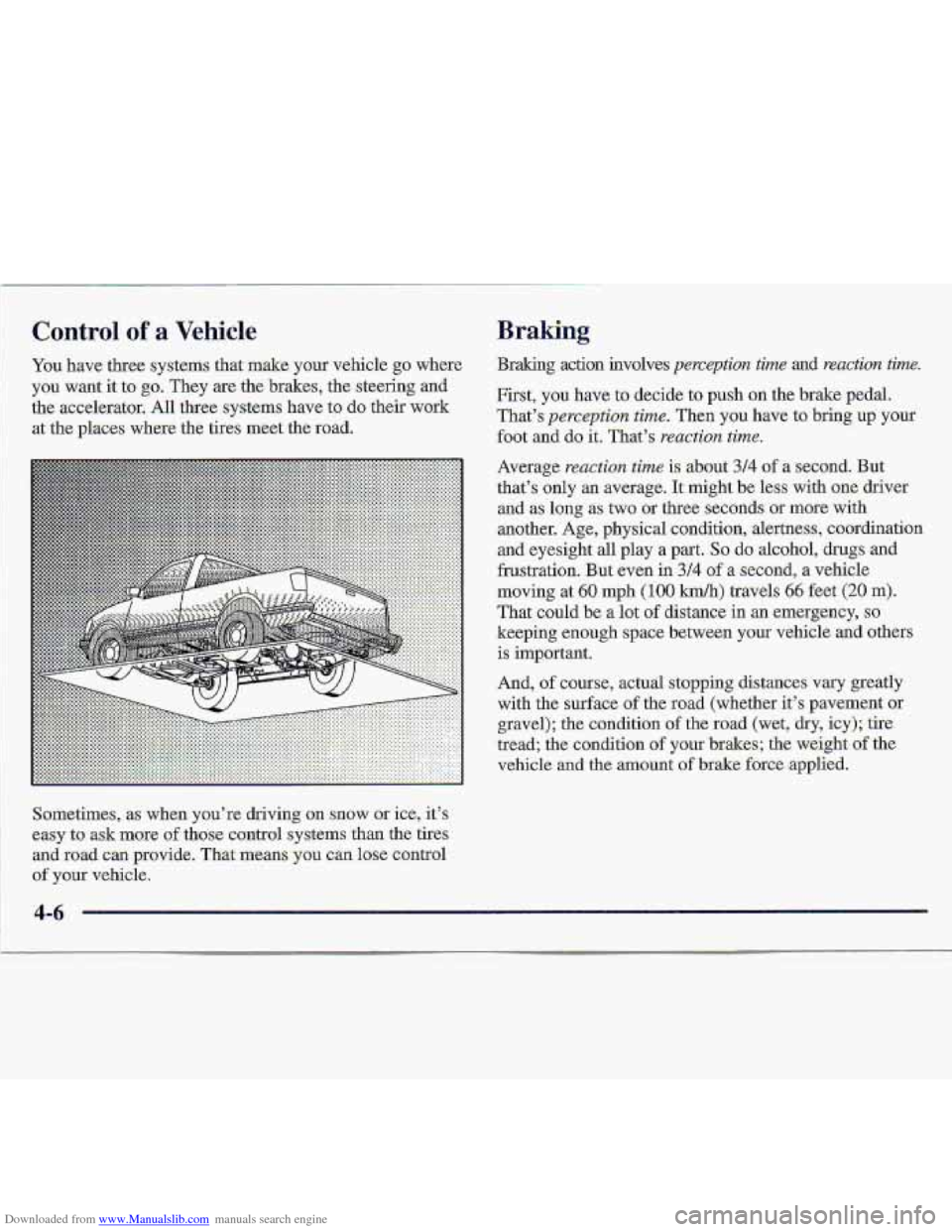
Downloaded from www.Manualslib.com manuals search engine You have three systems that make your vehicle go where
you want it to
go. They are the brakes, the steering and
the accelerator. All three systems have to do their work
at the places where the tires meet the-road. Braking action involves
perception
time and reaction time
First, you have to decide to push ob the brake pedal.
That’s
perception time. Then you.have to bring up your
foot and
do it. That’s reaction time.
Average reaction time is -about 3/4 of a second. But
that’s only an average. It might
.be less with me driver
and
as long as two or three seconds or more with
another. Age., physical condition, alertness, co.ordinati.on
and eyesight
all play a part. So do aIcohol, drugs and
frustration.
But even in 314 of a second, a vehicle
moving at
60 mph (100 km/h) travels 66 feet (20 m).
That could be a lot of distance in an emergency, so
keeping -enough space between your vehicle and others
is important,
And,
of course, actual stopping distances vary greatly
with the surface
of the road (whether it’s pavement or
gravel); the condition
of the road (wet, dry, icy); tire
tread; the condition of your brakes; the weight of the
vehicle and the amount
.of brake force applied.
Sometimes,
as when you’re driving on snow or ice, it’s
easy
to ask more of those control systems than the tires
and road can provide. That means you can lase c.ontrol
of
your vehicle.
4-6 .-
Page 146 of 402
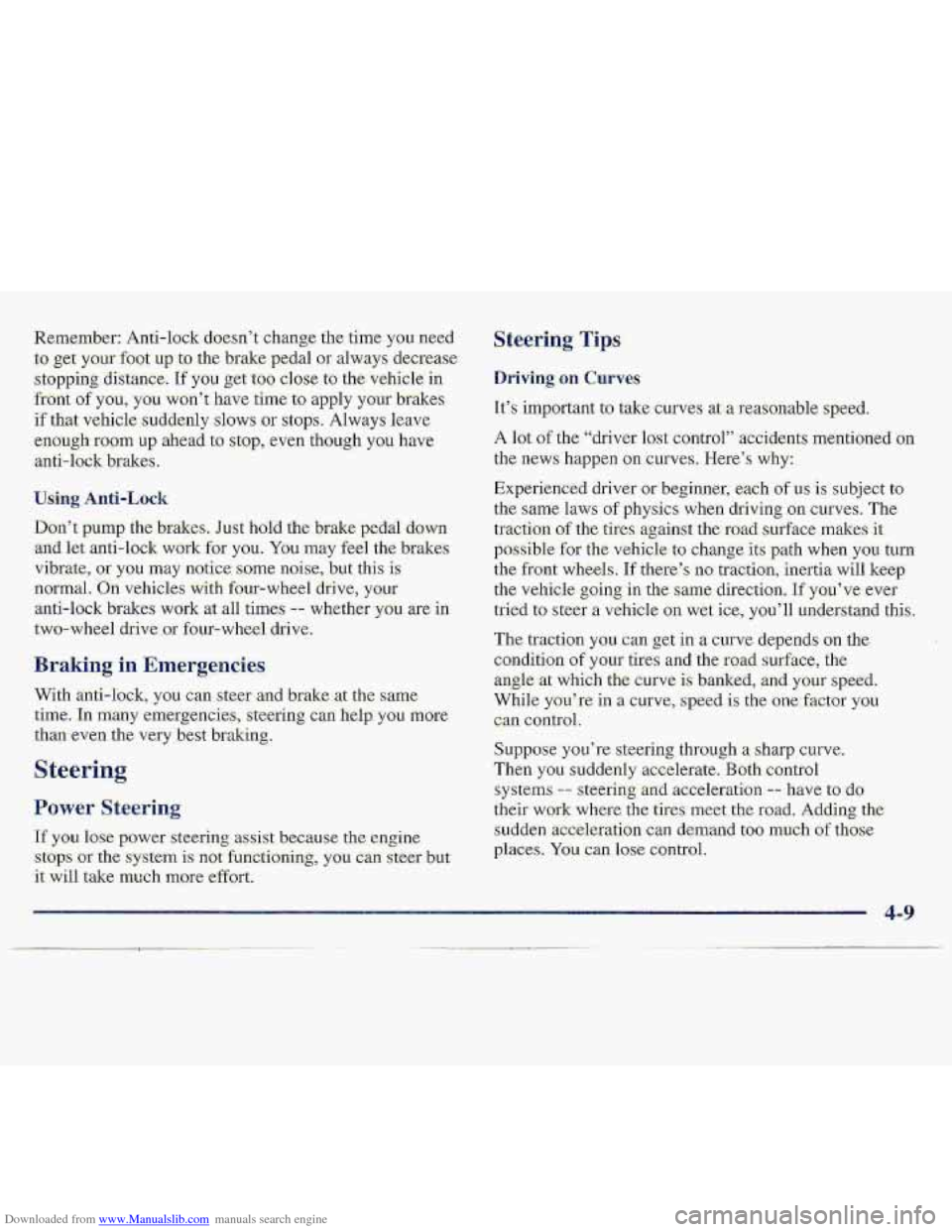
Downloaded from www.Manualslib.com manuals search engine Remember: Anti-lock dsesn’t change tbc- -time y.ou :need
:to get yo.ur fo~t up to .the brake ped,ai or always decrease
stopping
diskan&. If.you get-to6 cl~,se to thcvehicle in
front of YOU; you won’t have time to apply your brzikes
If.th:at vehicle suddelily .slows or siop-s. Always i-eave
e.nough mom up ahead to si.op, even though you have
anti-lockrbpkes.
U.s,ing.Anti.-LthA
Don’t pump the’bisakes. Just hdd the brake pedzl down
and let anti-lock wark..fox you. You ‘may feel the brake.$
vibrate., or you-may notice som-e noise, but this is-
::normal. Ofi vehicles Mth-four-wheel drive, your
;anti-lockbrakes work at all times- -- whether ,you are in
two-wheel driveor fuur-wheel:&.ive.
Braking in Emergencies,
With m-ti-lock, you can steer and brake at thc same
.time-. In many emergencies., st.eering can kip, you more
than even the very $est braking.
Power Steering
If you lose p~wer steeringatssist because the e.ngine
stop;s or the system is not fiw.dt?orriag, you can ste.er .but
it will take much more effort.
Steering Tips
It’s important to take c.urv.es at a reasonable sp-eed.
A lot of the “drivet lo‘st ci3ntml”‘accidents meritionedl ~li
the slews happen on curves. Here’-s why
Page 148 of 402
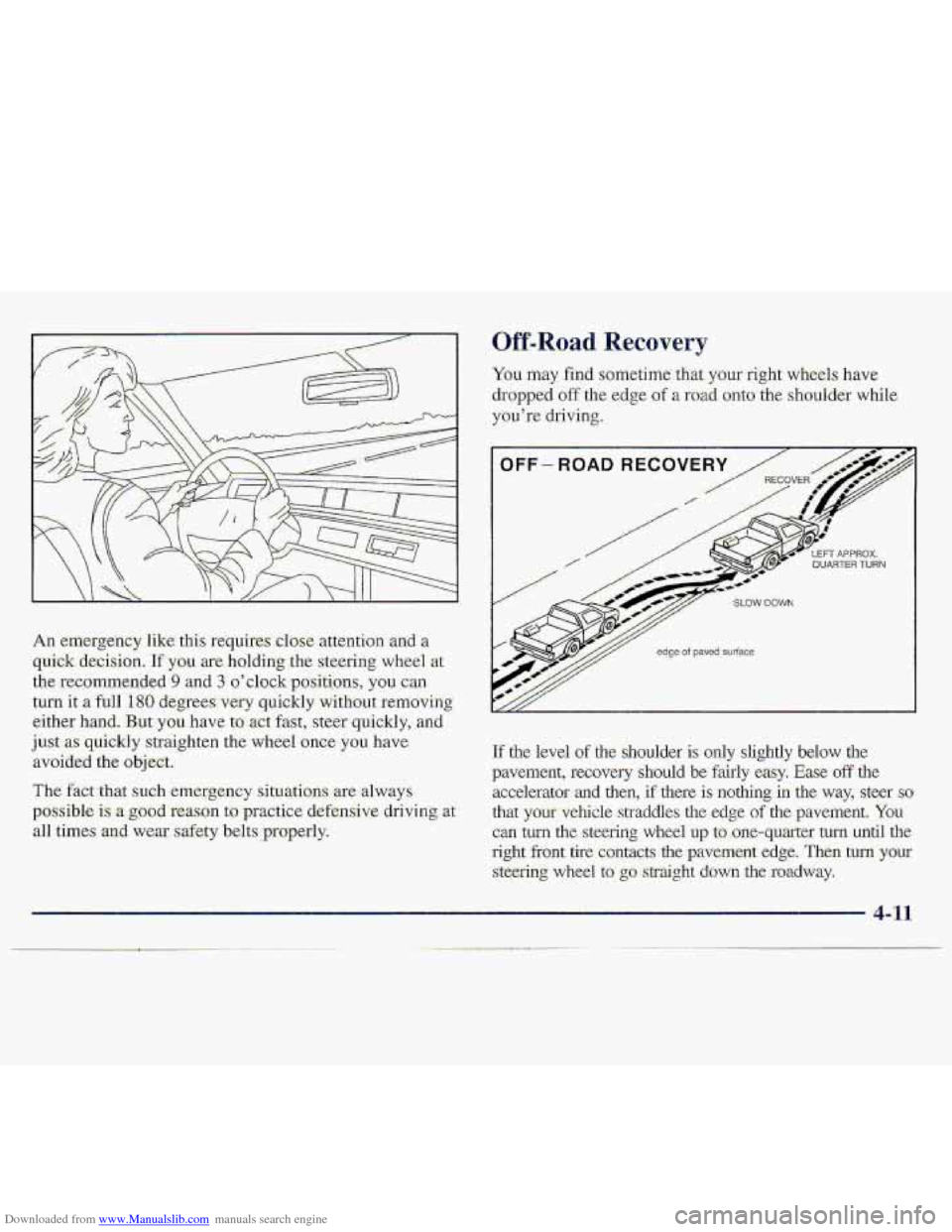
Downloaded from www.Manualslib.com manuals search engine An eri~rgency like this requires t10 ,attintion .arid a
quick decision. 1fy.0~1 are. holding the steering wheel at
the rec,omme,nded-9 and
3 o’elock-..positims, you can
turn it a full 180 de,grees. very quickly without removing
eith.er
hand. But you have tomt hst, ste,er quickly, and.
just as quickly straighten the wheel once you have
avoided the object..
The fact that such emergency situations ..me always
possible
is a-goD.d reason to pmctice. defensive driving at
all times and wexr safety b.elts properly.
Off-Road Recovery
You may find soriletime that your right wheels have
dropped off the. edge of a road onto the shoulder while
y~i’re
driving.
Tf the level of .the shoulder is only slightly below the
pavemefit, recovery should be fairly easy. Ease off tlie
accelerator
and then, if there is nothing in the way7 steer so.
that your-vehicle straddies the edge of the pavement. You-
cm turn the st.eering wheel up taone-quarter turn until the
right front tire contacts -the pavement edge. Then turn your
steering wheel to’ go straight dawn the roadway,
Page 150 of 402
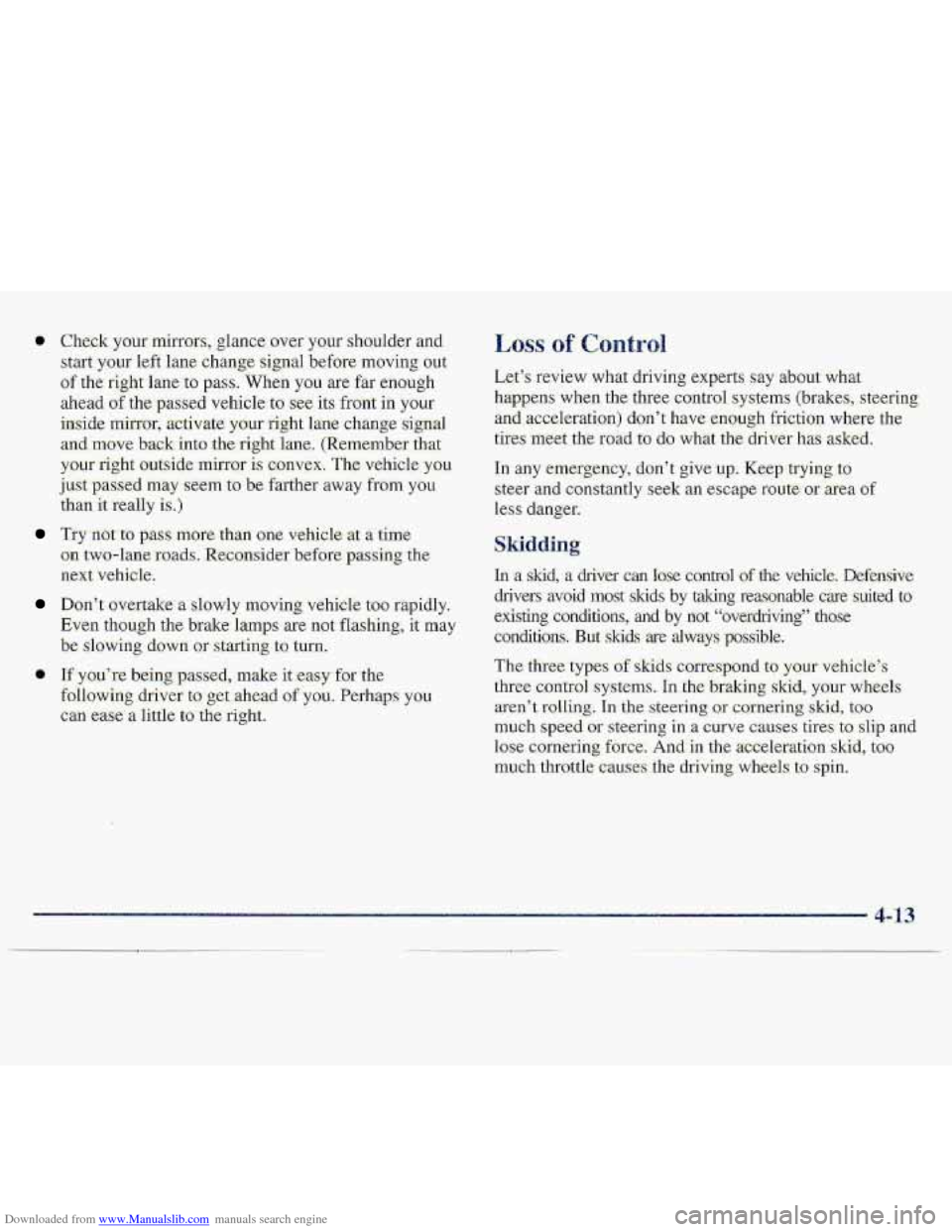
Downloaded from www.Manualslib.com manuals search engine * Check your mirrors, glance over your shoulder and.
start your left lane change
signal before-moving out
of the right.lane to pass. When you are far enough
ahead
of the passe.d vehicle to see its front in your
inside -01, activate your right lane change sigmd
and-move back into the.
ri,ght lane. (Remember that
your-right outside ,mirror is convex. The vehicle you
juslpassed may
seem to be farther away from y6u
than it really is.)
Tfy not co p.ass mufe ,than one vehicle ,at a time
on two-lane’roads. Reconsider before passing the
next vehicle.
D.on’:t overtake-.a slowly moving vehi-de too rapidly.
Even though
the brake -1amp.s are not flashing, it m.a.y
be slowing down or starting to, turn.
Qi If+ you’re being .passed, make it easy- for the
fallowing driver to
get..ahead .of you. Perh,aps you
can ease.&
little to the right.
Let’s review what driving expmts s-ay about what
happens when the thre.e
con.trol systems- (brakes., steering,
and,acceleration) don’t
have enough friction where the
tifes ”meet the road to do what the drivt?r has asked..
In any emergency, don’t give up Keep trying to
steer and constantly seek
an escape route-or aea of
less danger.
In a. skid, a driver cn lose control of .the vehicle, Defensive
drivers .avoid
most skids by taking reasonable care suited t9
existing conditiolrs, and by not “overdriving” those
conditions.. But- ,&ids
are always -pa.ssible.
The three typcis of skids correspond to your vehicle’s
three
c’0ntro1 syst,erns. In. the. brakifig skid, y0.m whe.eIs
aren’t rpl.ling. Ln the steering or- cornering skid, too
much speed or steering in a curve causes tires: to slip and
lase cornehg, foxce,. And. in the acceleration skid, too
much throttle causes the driving wheels- to spin.
4-13
Page 155 of 402
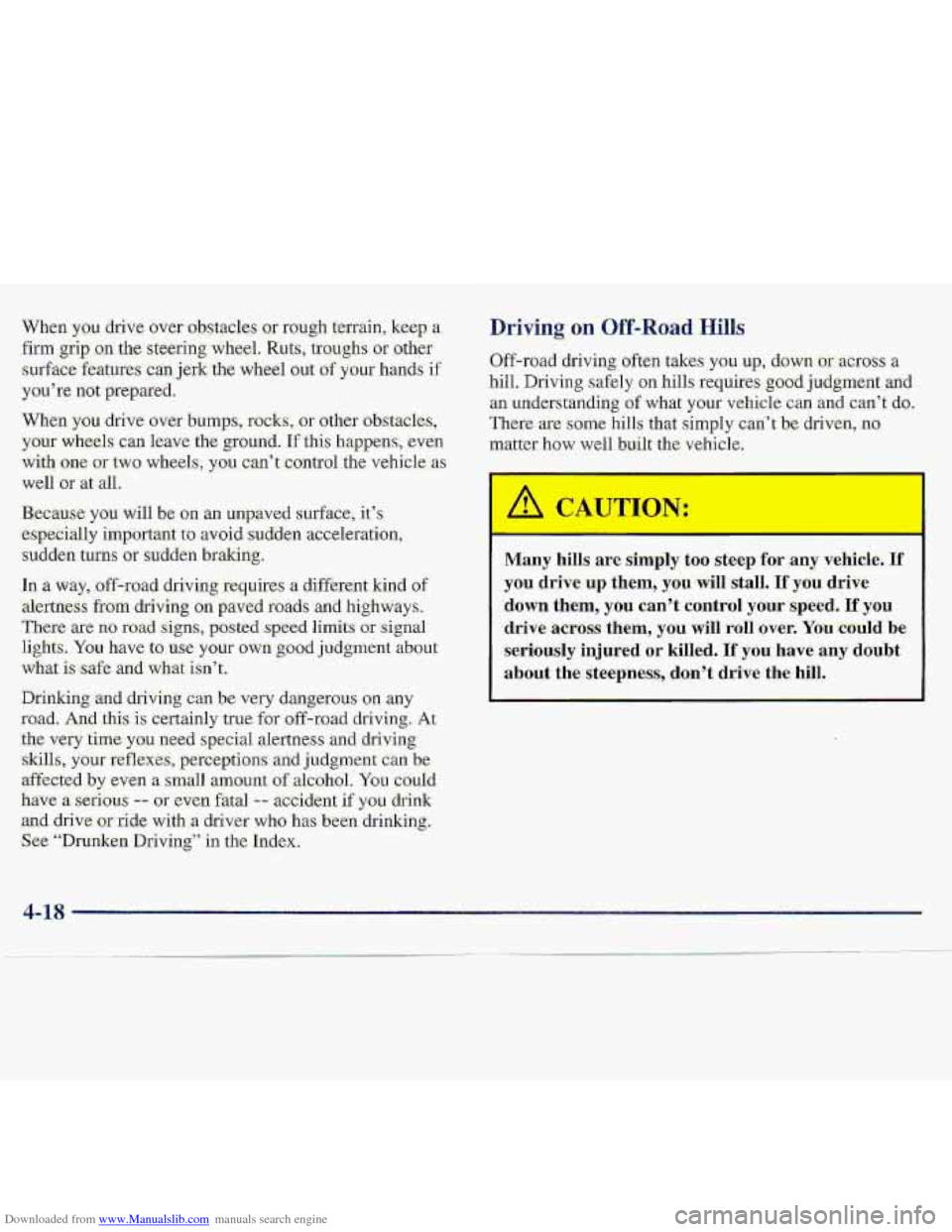
Downloaded from www.Manualslib.com manuals search engine Whe.n y0.U drive over obstacles .or rough terrain, keep a.
firm..gkill .on the steering wheel; Ruts, troughs or ather
-surfaace’featu?es- %a~l jerk-the wheel out of your hands if
you’re not prepaced,
.When YOU drive oTt.er humps, rock.; .or other obstades,
YOW wheels can leave the gr.ound. Ifthis happens, e-ven
with. one or tw~ wheels, you cdt co.ntrol the vehicle as
well or-at all.
Eecaus-e you will be on an un-paved surface, it’s.
.espe&dly importmt to avoid :sudden acceleration,
sudden:.tums
of sudden. braking.
In a way, .off-.road driving requires a diffkrent. kind of
:alertfie$s fmm driving on paved roads :and highw-ays.
There are no road signs, pastdspeed limits or signal
lights.
-You have to. use your own good judgment abaut
.what &-..safe and what- isa’t.
Drinkiagmd driving can be very dangerous on any
mad.
And’this. is -certainly trclcfor off-road driving. At
‘the very ‘time you need special alertness and driving
skills., y-owr-x&kx&$-, pefcepions and judgmen-t can be
affected by even a small amount of -alc30hol. You .c:ould
have a serid;us- -- 01- even fatal -- ciccident if you drink
and. drive wride with ,a driver- who has. been drinking.
See ‘“Drunk@n Driviy” in the Index.
Driving _. . on Off-Road Hills
Off-road driving often- takes you up, dswn.~~ acr0s.s a
hill, Driving safely on. hills requires good judgment and
.an tl.nderstanding of what your vehicle can and can’t-do.
There are some h.ills that simply cadt .b&, driven, ‘no
mattee how well built ,the vehicle.
Many hills are simply too steep for, any vehicIe. If
you drive up them, you will stall. If you drive
down them, you can’t control your speed. If you
drive across .them, you will roll over. ‘You could be
seriously injured
or killed. If you have any doubt
about
the steepness, don’t drive the hill.
4-18
Page 164 of 402
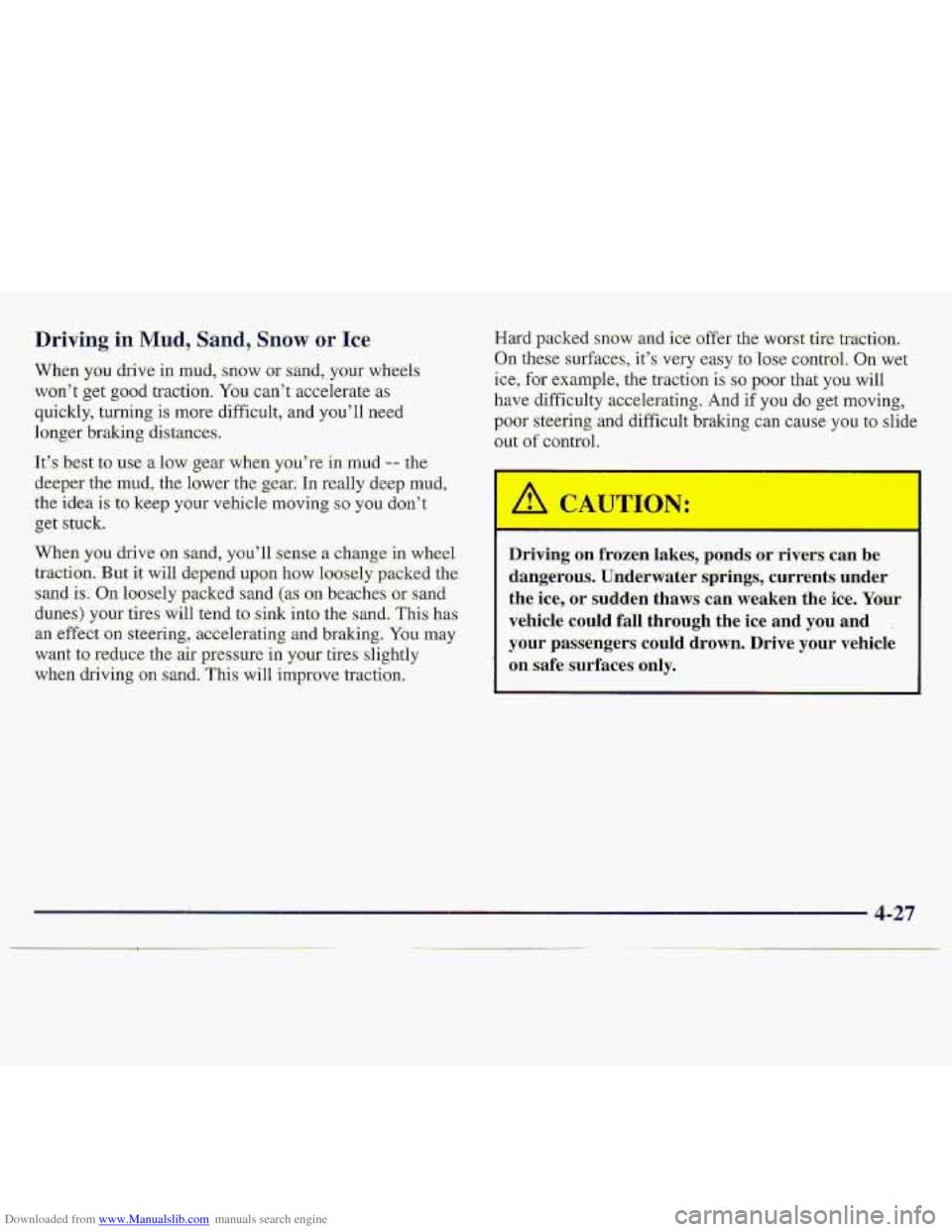
Downloaded from www.Manualslib.com manuals search engine Driving in Mnd, Sand, Snow or Ice
When you dxive in mu.d, snow or sarsd, your wheels
won’t get good traction. You can’t accelemte as
quickly, turning i.s more dif€icult, and you’ll need
longer braking distances.
It’s best .to use a low..gear when you’re in mud -- the
,deeper the mud, the lower the gear: In really ,deep mud,
$he idea is to keep your vehicle- moving s.0 you don’t
.!get stuck.
When
you drive on sand, yo-u’ll sensg a change- in wheel
traction, But St will &pmd upon how looseiypacked the
,sand is. On loosely packed sand (as on. beaches or sand
dunes)
your tires will tend to sink into the sand. This has
an effect on steering, accelefating and braking. You may
,w.ant to reduce the air pressure in your tires slightly
when driving on :sand. ‘This. will improve traction,
Hard packed mow ;sad ice. oEer the wofWtire’tractioa.
On thes~e s-Urfac.e.s, it’s very easy to lase c.on!Td, On wet
ice, for example, the traction i.s so paor that you will
h,ave diffic-ulty
accelerating, And if you d:o gkt movi.ng,
poor sleeting and difficult braking- can cause you to slide
out of control.
Driving on frozen lakes, ponds or rivers can be
dangerom. Undewater sprirmgs, currents under
the ice, or
sudden thaws can weaken the ice, Your
vehicle could fall through the ice and you and ,
your passengers could drown. Drive your vehicle
on -safe-surfaces only.
Page 180 of 402
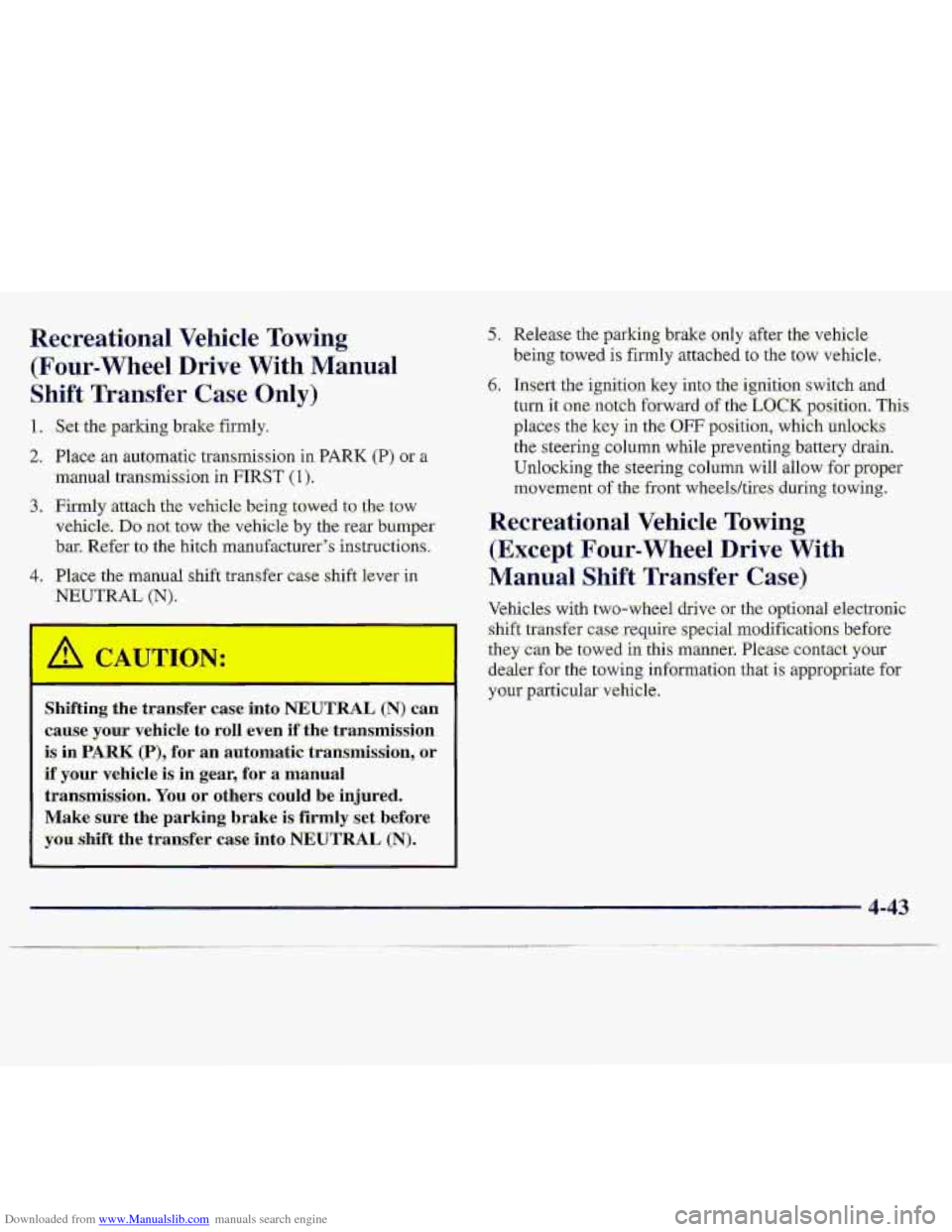
Downloaded from www.Manualslib.com manuals search engine Recreational Vehicle Towing
(Four-wheel Drive With Manual
Shift Transfer Case Only)
1 * Set the 1 'king brake: firmly.
2. Place an auromatic transmission in PARR (P) qr a
-manual transmis'siori in FIRST (1).
3. Firmly attach the vehicle .being towed to the 'to,w
vehick. Do not tow the. v&icle by the rear bumper
bar. Refer to the hitch manufactu.rer's instructions.
4. Place the manual shift transfer case- shift lever in
'NEUTRAL (N).
Shifting the transfer case into NEUTRAL (N. an
cause your vehicle
to roll evenif the transmission
is in PARK (P), for an automatic transmission, or
if your vehicle is in gear, for a manual
transmissi6n.
You or othets could be injured.
Make sure the-parking brake is firmly .set befbre
you shift the transfer case into NEUTRAL (N).
5. Release the parking brake only after the -vehicle,
being
towed is firmly attache-d to the tow vehicie.
6; Ins-ert thei-gnitiaa key into the ignitim switch md
turn it one notch fixward of the LOCK position. This
places the key in the OFF po'sitiofi; which 'ufilocks
the steering column while preventing battexy draia.
Unlocking the
steering column will allow for proper
rnovemcnt of the:front w'beel.s/tirr;s during towing.
R-ecre.ationa1 Vehicle Towing
(Except Four-Wheel Drive With
Manual Shift Transfer Case)
4-43